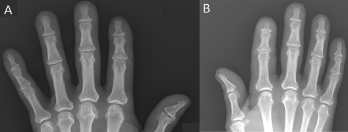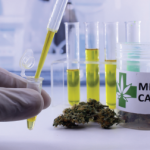
Figure 1. Acro-osteolysis with resorptive changes of the tufts of the distal phalanges of (A) the left first, second and third digits, and (B) the right second and third digits.
No joint swelling or tendon rubs were present. No rashes or skin tightening at any other sites was seen. His anterior chest was sun damaged, with occasional telangiectasia. No other telangiectasia at any other location, including the oral mucosa or palms, was noted. The neurologic, cardiovascular, pulmonary and the remainder of the musculoskeletal examinations were unrevealing.
X-rays revealed acro-osteolysis of the distal phalanges of the affected fingers (see Figure 1).
The patient was started on oral vasodilators, nifedipine and sildenafil for the digital ulcerations. Intravenous antibiotics were also initiated for a superimposed cellulitis of the right second finger.
An orthopedic surgeon did not recommend surgical intervention on the right second digit for complicated soft tissue infection.
Arterial ultrasound showed no occlusive thrombus or stenosis of involved extremities. Transthoracic echocardiography excluded an intracardiac thrombus. The patient had a normal complete blood count, basic metabolic panel and coagulation profile. The hepatic function panel showed mild transaminase elevation (see Table 1). Laboratory testing, together with the history and exam, reasonably excluded autoimmune disease, hypercoagulable state and diabetes mellitus (see Table 1).
Computed tomography of the chest, abdomen and pelvis showed no evidence of vasculitis or pulmonary parenchymal disease, but atherosclerosis of the superior mesenteric and coronary arteries was seen. An invasive angiogram of both upper arms showed widely patent bilateral large vessels with severely diminished flow into the radial and ulnar arteries distally, with numerous corkscrew collateral arteries in the forearms (see Figure 2).
Table 1: Selected Laboratory Testing
| Laboratory test | Patient result | Normal values |
|---|---|---|
| Serum glucose (fasting) | 87 mg/dL | 74–106 mg/dL |
| Aspartate aminotransferase | 44 U/L | 11–35 U/L |
| Alanine transaminase | 57 U/L | 10–49 U/L |
| Erythrocyte sedimentation rate | 32 mm/hr | 0–26 mm/hr |
| C-reactive protein | 2.77 mg/dL | 0.0–0.5 mg/dL |
| Rheumatoid factor | 20.3 IU/mL | 0–14 IU/mL |
| C3 | 138 mg/dL | 90–170 mg/dL |
| C4 | 41.6 mg/dL | 19–52 mg/dL |
| HIV screen1 | Nonreactive | Nonreactive |
| HBsAg | Nonreactive | Nonreactive |
| HBsAb | Nonreactive | Nonreactive |
| Hepatitis C antibody | Reactive | Nonreactive |
| Hepatitis C RNA VL | 264,657 IU/mL | ≤25 IU/mL |
| SARS-CoV-2 PCR | Negative | Negative |
| Thyroid stimulating hormone | 2.70 mcIU/mL | 0.4–4.7 mcIU/mL |
| Calcium (serum) | 9.3 mg/dL | 8.7–10.4 mg/dL |
| Parathyroid hormone | 32.6 pg/mL | 11.1–79.5 pg/mL |
| Anti-nuclear antibody | 1:80, nucleolar pattern | ≤1:40 |
| U1-RNP antibody | <0.2 U | <1.0 U |
| Smith antibody | <0.2 U | <1.0 U |
| dsDNA antibody | <12.3 IU/mL | <30.0 IU/mL |
| Scl-70 antibody | <0.2 U | <1.0 U |
| Centromere antibody | <0.2 U | <1.0 U |
| ANCA proteinase 3 | <0.2 U | <0.4 U |
| ANCA myeloperoxidase | <0.2 U | <0.4 U |
| β-2-glycoprotein-1 IgG | <9.4 U/mL | <15.0 U/mL |
| β-2-glycoprotein-1 IgM | <9.4 U/mL | <15.0 U/mL |
| Cardiolipin IgG | <9.4 MPL | < 15.0 MPL |
| Cardiolipin IgM2 | <9.4 MPL | <15.0 MPL |
| Cryoglobulins | Negative | Negative |
| SPEP/SIFE | No monoclonal Ig | No monoclonal Ig |
Key: HIV: Human immunodeficiency virus; HBsAg: Hepatitis B surface antigen; HBsAb: Hepatitis B surface antibody; RNA VL: Ribonucleic acid viral load; SARS-CoV-2 PCR: Severe acute respiratory syndrome coronavirus 2 polymerase chain reaction; U1-RNP: U1 ribonucleoprotein; dsDNA: Double stranded deoxyribonucleic acid; ANCA: Anti-neutrophil cytoplasmic antibody; Ig: Immunoglobulin; SPEP/SIFE: Serum protein electrophoresis/serum immunofixation
Notes
1 HIV antigen/antibody combination assay simultaneously detected HIV-1 p24 antigen, antibodies to HIV-1 (group M and O)—IgG and IgM, and antibodies to HIV-2—IgG and IgM.
2 Lupus anticoagulant was not obtained because the patient was receiving low-molecular weight heparin for deep venous thrombosis prophylaxis.
At this juncture, we explicitly questioned the patient on his mode of cannabis administration and discovered he was a daily blunt smoker.



